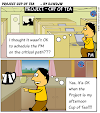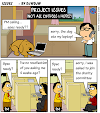- If you have teams in different time zones then email can be useful to handover status position and ask questions
- Another proverb I quote is "what is not written has not been said". I am very happy for document reviews to be outside email. "Review by circulation" is known to be the weakest quality technique. However, no verbal approvals please. Approvals need to be committed to an auditable approach and email is useful for this and preferable to the old ways of securing through physically signing some paperwork
- One to many communications like key status updates. I would keep the message punchy (no 7 page emails please) but by all means refer to a location on the Project File where more details can be found or to a Blog page etc
Email - Bad
- Emails that are too long. If it needs to be long at a minimum make sure the key points are put in the first two sentences
- Not being clear on what response is required when and who needs to give it. So, if you are looking for a response, please state this clearly including when you are expecting this (bold?). The people who you are looking to respond should be in the "To:" field with others that might respond or just need to be aware in "cc:" field Please give the recipients sufficient time to respond considering the other work they will have and the size of the task you have given them!
- Having an email with incorrect subject line. Lazy people can sometimes just pick a previous email and start a new conversation with a previous email as a starter. Urg!
- Spending lots of time on "email management". If team members are spending a lot of their project day doing email management (e.g. reading, responding, filing emails) rather than undertaking tasks on the project plan then this is bad news! Yes, you may need to find an old email but search tools have improved and encouraging putting something sensible in subject heading can further help via the subject:(keywords) Outlook search facility
- Emails can be ignored and often are, either explicitly or via bad email process (as people park and never go back to address). Unless the sender has the rigour to mark the sent email and chase for a response, the whole subject can disappear into the "ether". For this reason, a Project is well advised tracking mechanisms for such questions - a classic way is via a query log for questions so that things don't get lost in in-boxes and can be more easily followed up by regular reviews of the status of the log.
- Sending big attachments in emails within the Project team. Please have these within the Project File and send a link.
Email - Ugly
- Having chats on email. Some individuals are shy or lazy or both and engage on "email discussions" when they are in the same office. Get up to get out of their chair and have face to face discussions, it is more productive. By all means confirm the conclusion of the discussion in an email for the record. If people are not in the same office, there are better tools than email such as Instant Messaging
- Copying in the world combined with Reply/All. Some people like to copy in everyone to their email. And it always seems to be those emails which end up in a debate. Always encourage the team to think before copying "the world". Do the people on the cc list need to know about this email at this time. Can the people be informed when a conclusion is reached? I sometimes use bcc. This allows a senior stakeholder to be informed about a point (e.g. an Issue notification) but not suffer the "million" reply/all consequences
- Reply/All is surely the worst feature of Outlook! If people had to type in all the email addresses to be copied in a reply, less people would be copied for sure. It is far far too easy to press that button and not modify the distribution list. Hence my use of bcc described above.
- Complaining via email. Frankly, if someone is unhappy with someone else's performance, it is the best approach to pick up the phone and have a discussion one to one. The unhappy person, after the discussion, can always escalate to the person's manager as the next step. But they should not start with a "stroppy email" because these often end up with undesirable outcomes. At one end, the compliant can be ignored and behaviour becomes worse as a result of the email and at the other end it can all end up in a discussion with the HR department!
Conclusion
So in conclusion it is worth a Project Manager thinking about Email practices as part of running a Project. However I warn you that it may be difficult to change people's behaviour which is well ingrained (see post on Newton's laws!).I have used kick off sessions to talk about "expected behaviours" in general and Email can be included as part of that. During the project you can think about "naming and shaming" really bad offenders but after a quiet word on first offence please.
Other than that you should aim to best manage around some of the bad and ugly practices described above. So, think about query logs and similar strategies to ensure bad Email practices don't derail your Project.




.png)






.png)





5 Comments
Two questions David-
ReplyDelete1) Do you think its time for Kanban style discussion board tools instead of classic emails specially when the stakeholders are of same company? They are cloud based and provide a better view and control of email history.
2) Is it okay to remove few names from mail chain that are either too senior or not directly related without offending the person who added them in first place ( without much thought or an unnecessary escalation/ noise)?
Good point and nicely written. This is a nuance that could not have been included in PMBOK.
ReplyDeleteDivesh,
ReplyDelete1) I've no experience of such Kanban style discussion boards but can imagine they will improve things. With any such "new tools" the things I would look at as a PM are, who has access to them (business?) and has everyone been trained and agreed to use them? So IM is typically available widely in many organisations and improves certain communications over email but does everybody use it? Sadly email is often the lowest common denominator!
2) I don't see a problem personally although, as a courtesy, I typically put at the start of my reply in italics a quick note of adjustments to distribution list e.g. "looped in Toby, removed Mark & Sean". The email initiator can then loop people back in if they truly believe they need to see the discussion or better inform them at the end of discussion!!
David - lots of sensible advice. For my own part I would add:
ReplyDelete1. Turn email notifications off otherwise you are constantly being interrupted & productivity goes out the window.
2. Create a public Outlook folder for each project with sub folders for each workstream with appropriate access for the team and key Stakeholders. Team members then copy all important emails and diary events I to this. The PM/PMO manage these folders. I have done this for several years now, both as a PM and portfolio manager with 100 plus projects. This has saved my bacon on many occasions when staff have gone on leave/sick and I have been able to quickly pick up the project.
3. Set up Outlook to show mail by conversation. This allows you to quickly follow a thread and also let people know if they have gone off topic.
4. Use the "Clean up" function. The first thing I do when going into mail is to hit the clean up conversation button, so I don't waste time reading redundant emails.
5. Schedule specific times in your calendar (I have 3 one hour slots per day), to read and DEAL with mail.
6. Deal with your mail, don't just read and park it. Do something to action it (carry out an action, respond), Schedule a specific time in your calendar to deal with it, Delegate it to someone else or Delete it!
7. I'm not a great fan of instant messaging, unless working on a live issue or cutover with remote teams. However discussion boards in shared workspaces (e.g. SharePoint) are very useful as long as they don't get clogged up with stuff that doesn't add value.
Hope this is useful.
Stewart, some really interesting ideas from you here, most of which I have never tried. Initial feedback is as follows:
ReplyDelete1) A real cultural change, I could contemplate if IM is available for the immediate prompt
2) Risk from Newton's 1st Law here I feel (see my Blog Post on this)
3) Need to explore but sounds useful
4) Need to explore but sounds useful
5 & 6) Not sure I could dedicate 3 x 1 hour to this but agree with concept of dealing with mail, not just reading and marking for another slot which never comes. Delete it is a bit radical. I personally (not sure this is the best strategy but it is what I have used for a while now) is very quickly scan in preview and if I'm not going to do anything I don't delete but leave unread. If I am going to do something I open and do it if at all possible.So old unread emails are ones I ignored.
7) I think IM has a place for a chat (rather than pinging emails between several people). When you come to a conclusion, if people need to know or you want to record in minutes form, by all means summarise outcome in email